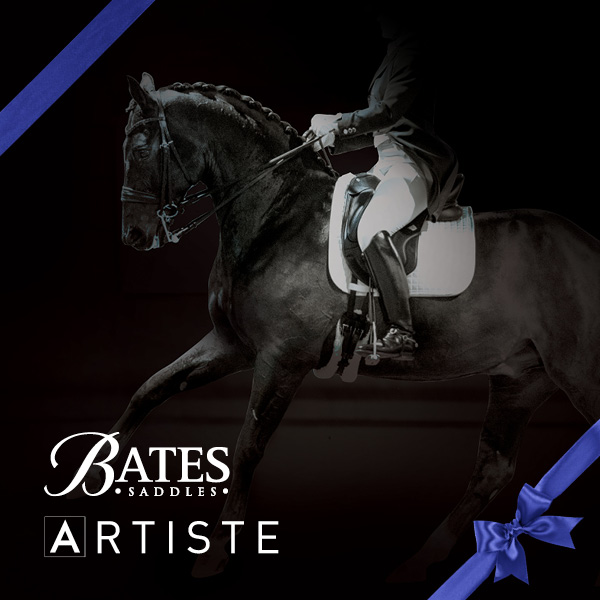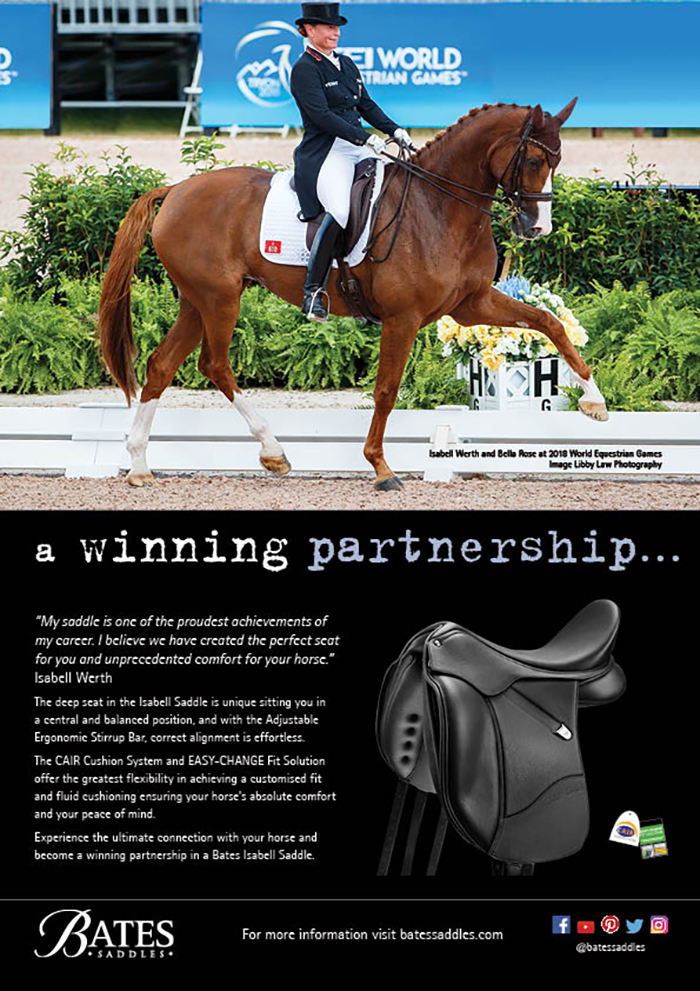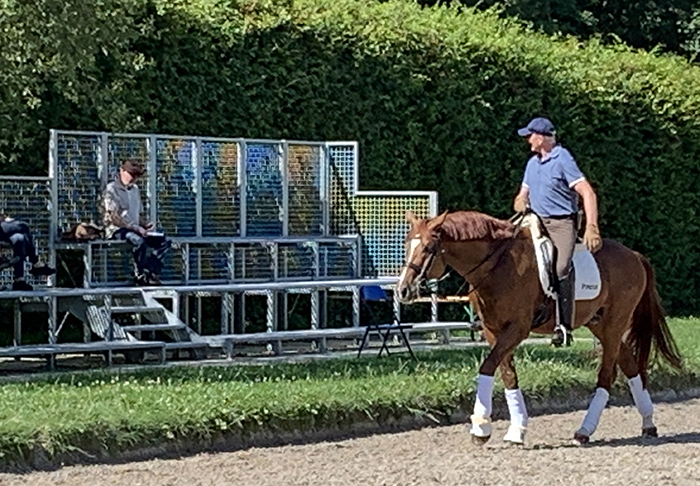
Story – Christopher Hector
Photos – Patrizia Ferrara, Roslyn Neave and Kenneth Braddick
Hubertus Schmidt’s dressage stables, Fleyenhof, have under-gone a total renovation since my first visit there over twenty years ago, it’s bigger, grander, fancier, but the message at the heart of the operation is still the same…
Although Fleyenhof remains a sanctuary for civilised riding, Hubertus and I agreed we have seen amazing changes in dressage breeding over the two decades…
“We have never had so many good horses. It’s absolutely crazy this year for the team to the Europeans, my horse had a bad day at the German Championships but with a score of 77%, I was sixth in the Germany. Can you imagine, with 77%? And you come sixth!”
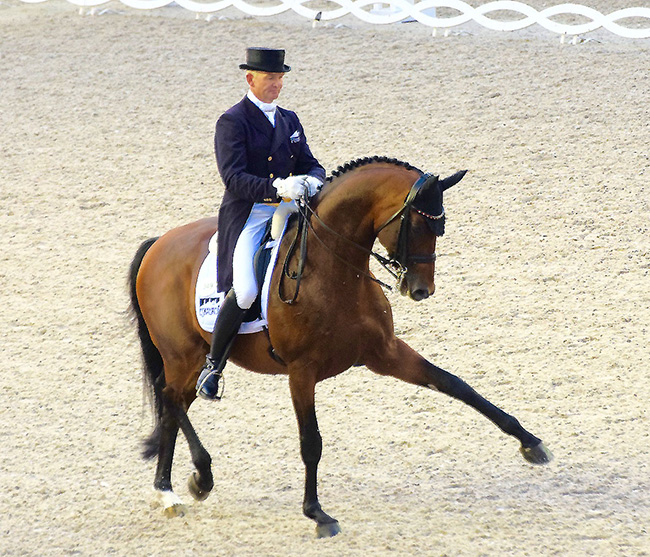
Imperio – 77% and you come sixth!
The horses may change, but the principles remain.

Hubertus riding beside a corn field the day we first visited him
“We first spoke twenty years ago, I am twenty years older, but the system is still the same!”
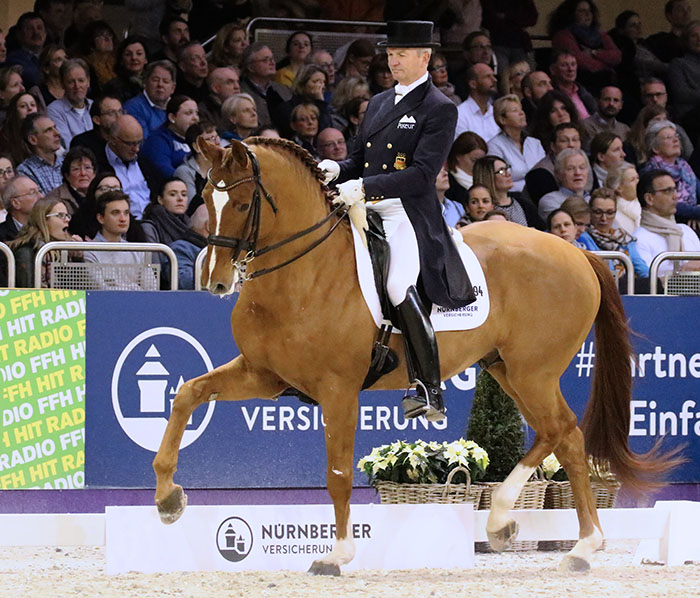
Bonamour at Frankfurt Show….
“The horse I am riding today is Bonamour, he is by Bonifatus out of a mare by Rousseau. I showed him in Balve and he won the Nurnberger qualifier, and then I took him last December to Frankfurt, half a year later, without any other shows, because I know he is not spooky. Okay the first time in the big Frankfurt arena, he was a little more excited than I thought he’d be, but he is super easy, he has a very good character, so clear and strong in the mind, I have never had a horse of this quality, so easy.”
When you started riding this morning, you had his nose just behind the vertical, and there are stupid people who would say, oh look rolkur, but it is nothing like rolkur…
“It’s totally different. That was at the very beginning, and I made the horse very long and low in the neck. It was the same the first time you came here 20 years ago, I don’t start to collect before the horse is stretching forward and down into the bit. Not every horse that is forward and down is loose in the back, but if the horse is not stretching, he is not loose and forward. I want to be able to get them forward and down, dressage is also gymnastic, so at first I had to get him a little bit round to get him low enough in the neck, and as soon as he is low enough, then I let him out again. At first he was a bit too high for me, so I had to have him a little shorter in the neck to get him lower in the neck, and as soon as he gets low, I let him out. That is the second step.”
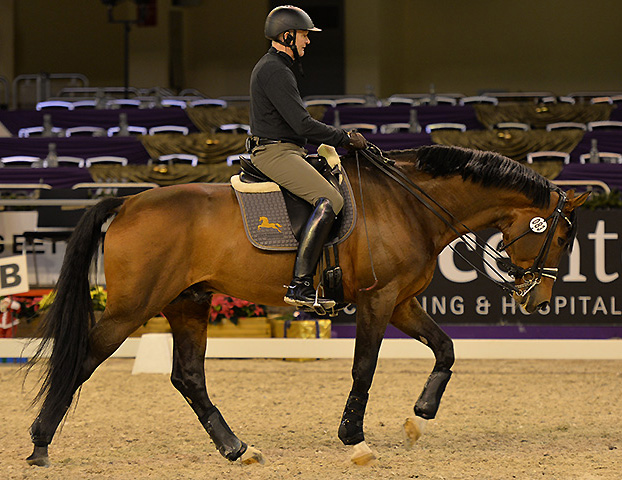
“If I can’t get him immediately low and out, then I have to make this compromise, and if I can’t get him low enough with his nose in front of the vertical, then I make him a little bit shorter in the neck, then low in the neck, then in the second step, I take him out.”
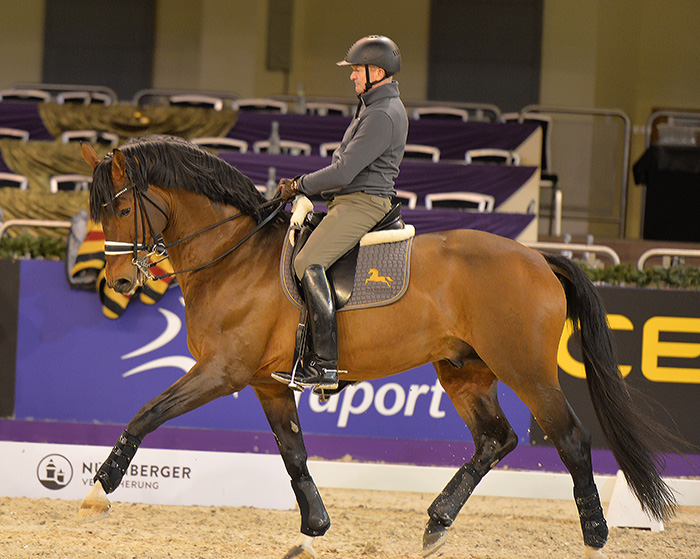
“If they are a little bit stiff, you have to bend them sideways and again a little shorter in the neck, but what is important is that I can be soft after that.”
“It is the same as later on in the collected work. If the horse gets a little too strong, too much against the hand, I have to make him a little shorter in the neck, also if they are a little bit stiff, you have to bend them sideways and again a little shorter in the neck, but what is important is that I can be soft after that. It is the most important part of this philosophy, to make and keep them light.”
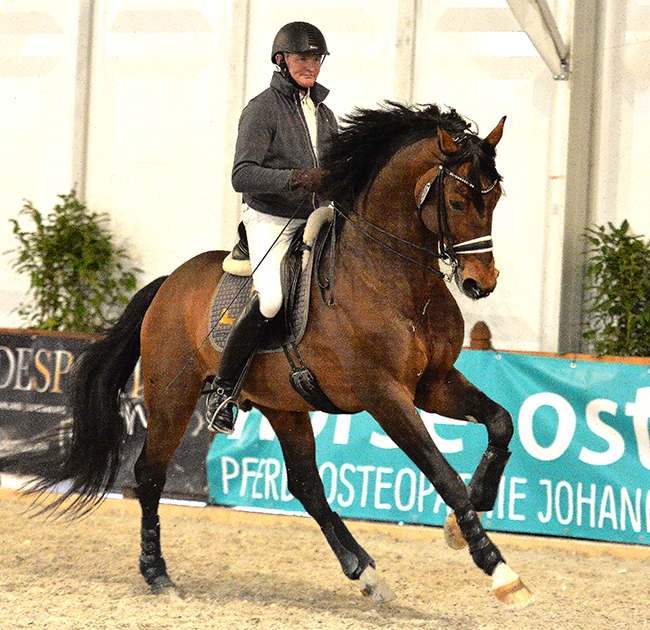
Working with Escolar – keeping him light
“It’s getting the reaction to what you ask. If I try and get more flexion, and the horse is a little bit stiff there, and I don’t get a reaction, then I do ask a bit harder, with the correct combination of the aids. That is always the most important when you are teaching, you never use aids in isolation, it is always a combination of the aids. A half halt is not doing something with your hand, it is sitting against it, pushing forward with your seat, maybe pushing forward with the inside leg, always with contact with the outside leg, the aids are used in combination.”
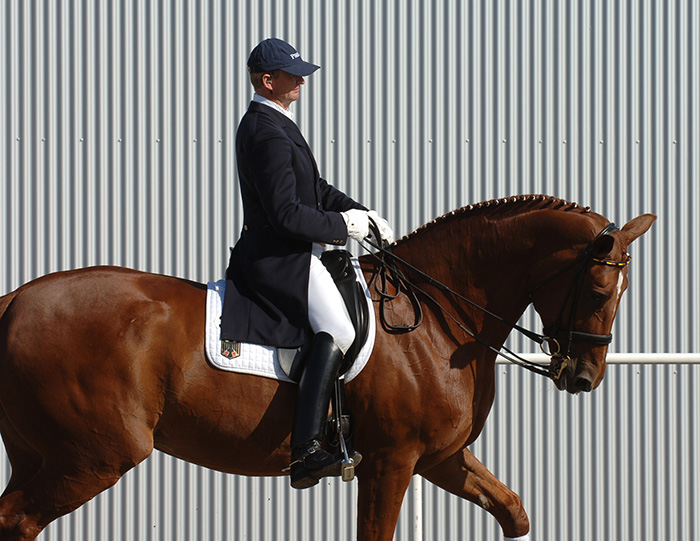
Hubertus and his Gold Medal winner, Wansuela Suerte demonstrate flexion
“If we are talking about flexion to the inside, it’s not just the inside hand, it is a combination of aids, that’s very important. And if I have to, I make the horse shorter to get the flexion.
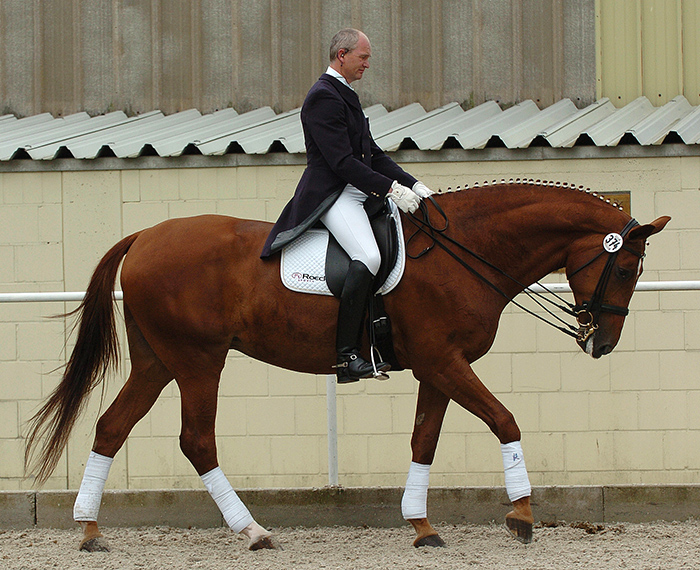
100% reaction from Wansuela
I immediately make the second step, a little soft in the hand, let him go exactly in the right frame, and then I try again to flex him a bit more. If he is doing this with the nose in front of the vertical, super, I give the feed-back, yes, exactly this. But if I get no reaction, I try again, you must 100% get a reaction, and it doesn’t matter if they get a little short in the neck, you must get the reaction from the aid.”
“It’s the same with everything, if I come with my leg and there is no reaction, then come a little harder, and it doesn’t matter if he kicks against my leg, or runs a little harder, but he has to do something. It is very important to make, and keep, them sensitive. That’s why sometimes I have to be a bit harder, and kick them with my leg. I always start my canter with just my calf, never the spur. For sure, later in the half pass or pirouette, you might need the spur to make them more active, but for the canter, only the calf, and horses only do that if you train them to be sensitive to it.”
“So if I come with my leg for the canter, and there is no reaction, I don’t keep squeezing, I stop and say, hey, one stronger leg, that was the aid for the canter. So then I walk, and I do the same quiet aid with my calf for the canter again. I am very strict about doing that, because then I can train them to be sensitive, or keep them sensitive.”
more follows
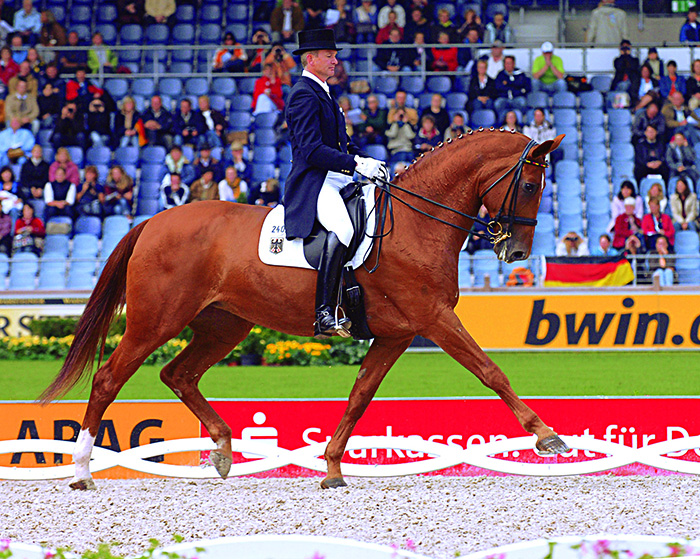
Wansuela Suerte (Warkant x Wachmann I) was ridden by Hubertus to capture the gold medal trifecta of the 2004 Olympic Games in Athens, the 2005 European Championships in Hagen, Germany, and the WEG in Aachen, Germany in 2006.
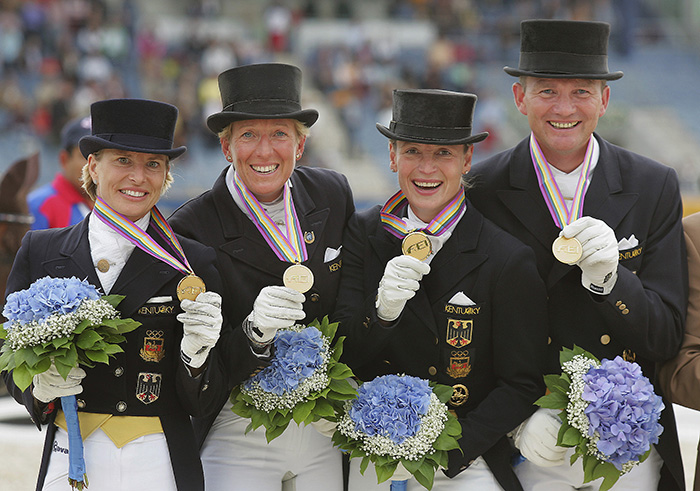
In 18 international competitions over four years, the pair placed first twice and second seven times. She was retired from competition in 2008. Pic is German Gold Medal team, Nadine Capellmann, Heike Kemmer, Isabell Weth and Hubertus at the Aachen WEG.
“With a horse like Wansuela, you almost never had to do that because she was always so sensitive, it was more, wait, don’t start for yourself. It was the opposite, and it is also sometimes very nice, but sometimes more difficult. But other horses, like Bonamour who you saw, is not super super sensitive by nature…”
But he looks so sweet…
“Yes, but you have to make him like this, and you have to maintain it. There are some very lazy horses that you never get so sensitive. Bonamour is sensitive, but not like Wansuela, he’s more just a little slow, and I say, come on, listen. Like when I did piaffe, the first one was really good, and the second was not so bad, but when I asked for a little more, there was no reaction and I said, come on – do it. Even if there was a break in the rhythm, and the piaffe is not as good as the one before, but after that I get my reaction again.”
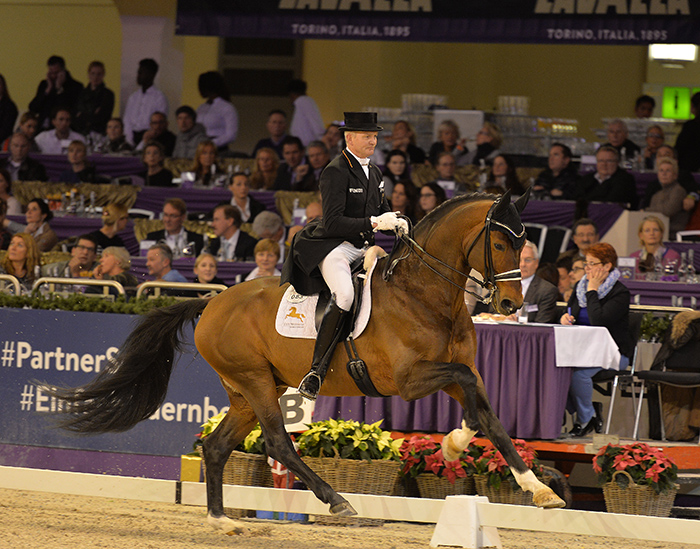
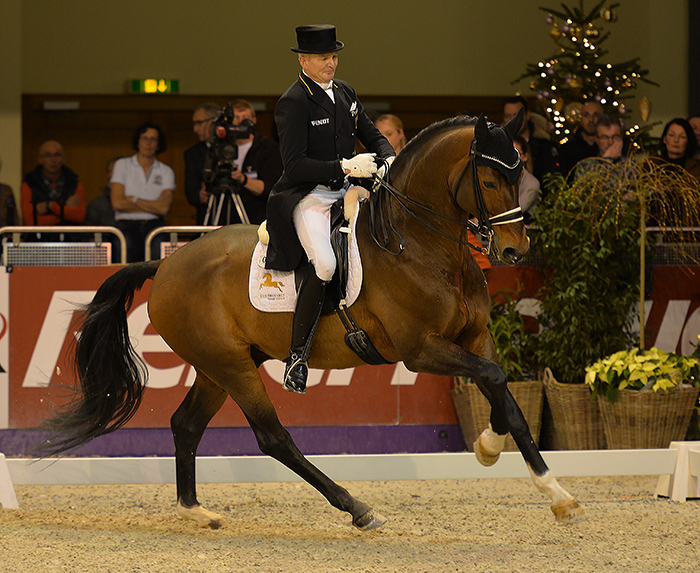
Escolar is one metre eighty and huge
“Different. Escolar is a huge horse, one metre eighty and huge, but he is getting better and better. If he was a lazy horse he would not do piaffe / passage – you see some lazy horses, when they go in the ring, you have no chance to get them to piaffe. He has had some really nice tests, his Grand Prix in Munich for example, that was amazing, he was really light, really tuned in, he was perfect. It is often a question of power, that the horse is strong enough.”
“For example, on the first day in Aachen I was very pleased, the piaffe/passage was really going, I did not have to work so much, then we had some stupid mistakes. Some were my mistakes, a few were bad luck, like coughing in the two tempis. The next day I worked a bit more because I didn’t want another test like that, and then I got him a bit tired. The second test wasn’t bad, but you could see that I had to work harder, help more. He’s green, don’t forget that was his fourth Grand Prix in his life, Aachen. And the third Special in his life.”
more follows
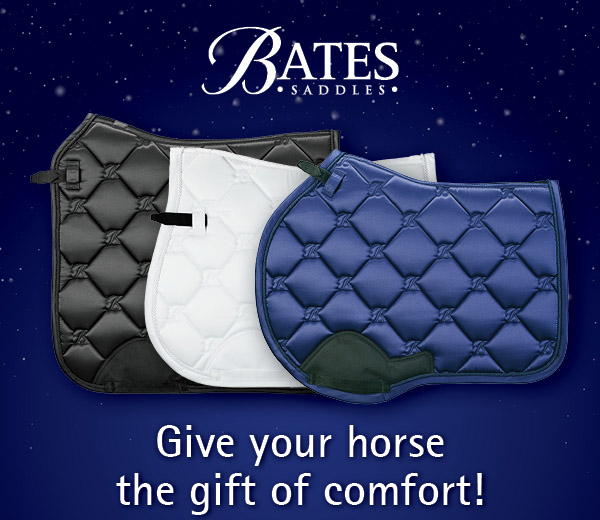
Visit www.batessaddles.com to find your nearest stockist or to purchase your Bates Saddle Pad.
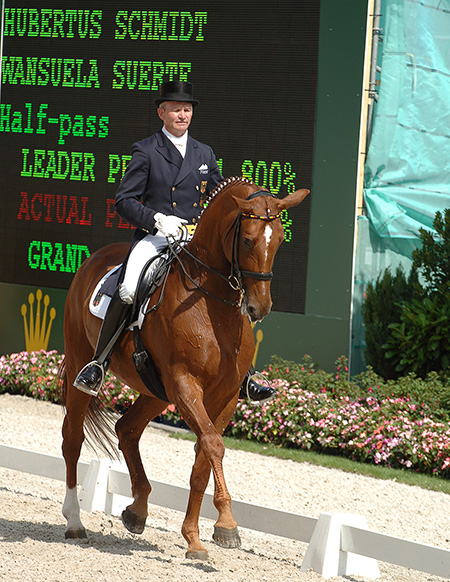
“But he is totally different to say Wansuela. She didn’t have these huge basic gaits like Escolar, but on the other side she was so sensitive and so nice, for that time, it was good piaffe and passage, good pirouette work and good canter work. The trot was a little bit poor in the extension and the walk…”
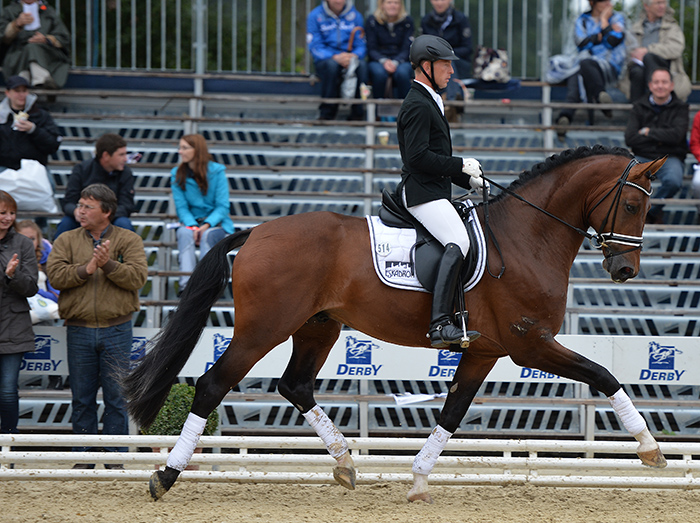
Escolar winning at the Bundeschampionate as a four-year-old
What was it like the first time you sat on Escolar?
“I was impressed the first time, even though he was just three-and-a-half. When family Schürner asked me if I wanted to ride him, I’d seen the video of when he was winning at the Bundeschampionate, ten for the canter, 9.5 for the trot and everybody said, you will never be able to collect him, with this canter you can’t get to Grand Prix. I was sitting on him and he was super, I could feel immediately that this would be a Grand Prix horse. Even though the canter was huge, you could make him shorter even then, and you could collect the trot and he still kept his rhythm and swing, so I was impressed with him from the beginning.”
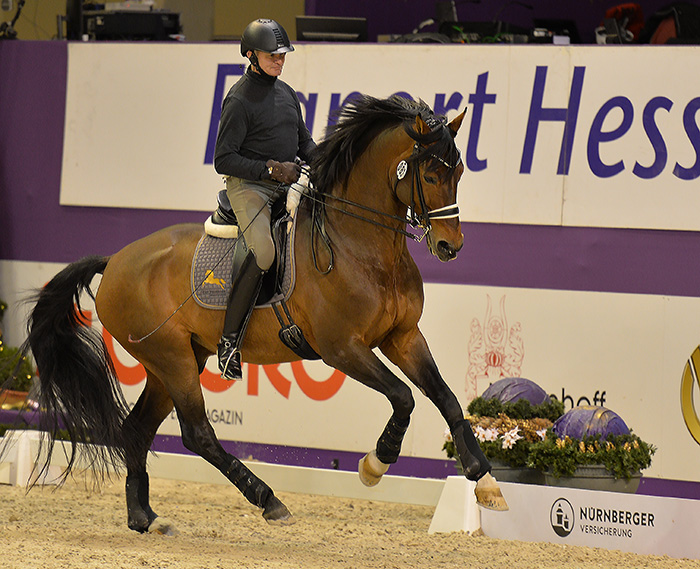
With a horse with as much movement as that, such big movement, what exercises do you use to teach him to collect?
“In principle you do nothing different to the other horses, the only thing is that for sure it takes longer, you need a little more patience. I also did lots of short exercises, because when Escolar is cantering, because it is so huge, it uses more strength than a normal horse, you can’t canter like for ten, fifteen minutes, I did lots of breaks in between. It was the same in the trot, even the trot is hugely big, so you have to be careful. But overall there is not a big difference with a actual work.”
With all your horses, you seem to have a lot of breaks during the working session…
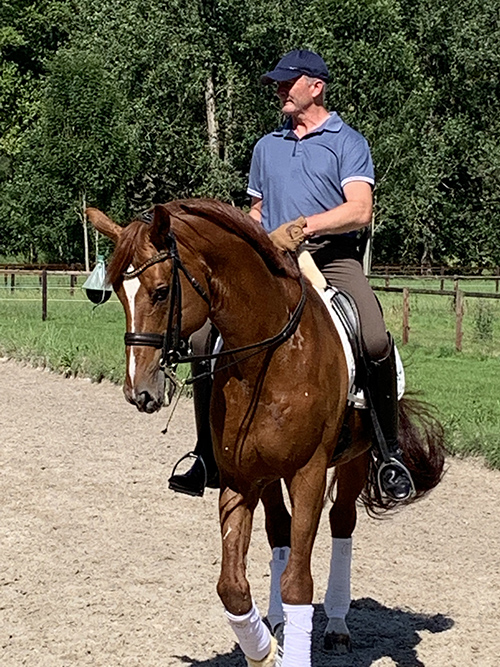
“Exactly. With every horse I do what I did today, that is my normal work when they are at this level. You start with something which is not so easy, with young horses that are just learning series changes, nearly every day you have to train the changes, four, three, two, one times changes, some on the quarter line, some on the half diagonal, just a few changes, mixed together. You have to work on the exercise to get the horses used to it, especially horses that get a little hot. But you don’t have to do every day your competition-size pirouettes, your half passes like in the Grand Prix, we very seldom do that. You do the basics, you have to have them supple on the circle, to have them through, swinging and sensitive and light, that is always the work.”
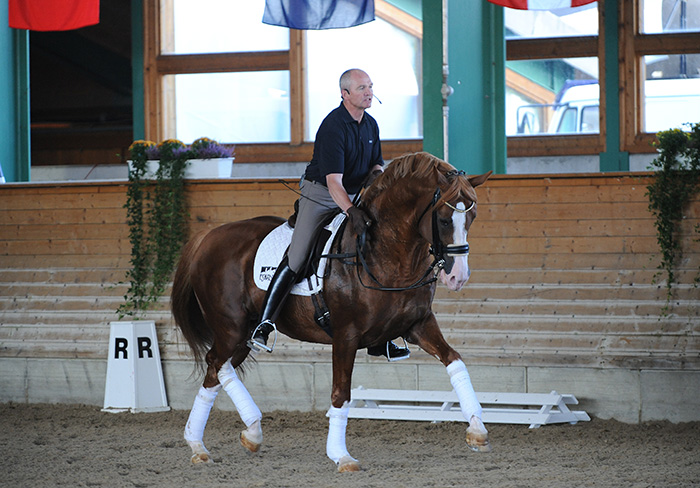
“I like to work them every day, but not too much, especially with the sensitive ones – which are the ones we need. With a four year old it is much better to do fifteen minutes every day and achieve what I need to, and not to work them so hard. If you work them every second or third day, then you have to do more to get what you want, but of course this all depends on the horse. In principle, I like it quite regular, five, six times a week, and not so long, and not every day all the movements that you have to do. That’s important, that you keep it interesting and it is not every day – shoulder in, volte, half pass, changes, pirouettes and so on, mix it, and work more on the throughness, on the basics.”
Do your horses go out of the arena?
“All our horses go out in the paddock. I still ride seven, eight horses a day, and with some, like Imperio, I take them out for a walk, and after every ride I take them down to the jumping field and go round that. But I’m a professional and I have many horses to ride, so I don’t have time to take all of them out, some my groom takes them all out for grass in hand. But every horse goes out in a yard. I have learnt with time, so we don’t have big paddocks any more, the yards are fifteen by twenty, so they have enough space to buck, they can roll a little bit, jump around, but they don’t get up any speed. We used to have twenty by forty, then you get speed and that’s where the most accidents happen, in the field even if you put them out every day. Now we have the rubber mats, so it is the same footing as the dressage arena. I want to let them run and buck a little bit, that is absolutely necessary, especially for the interior, the character.”
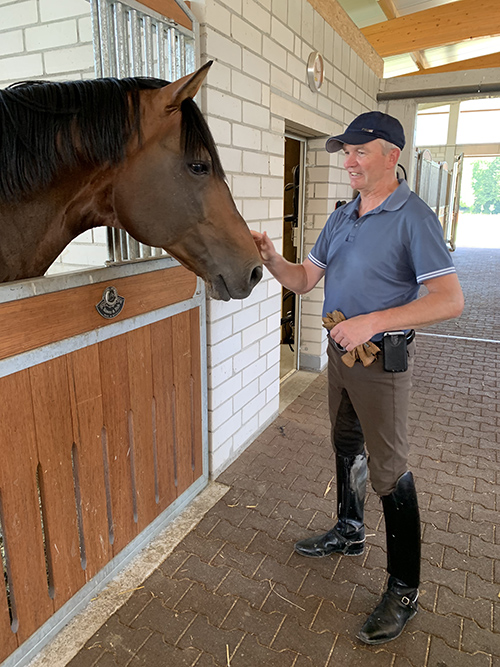
Fleyenhof is now home to a group of very exciting stallions – thanks to Escolar who started the breeding ball rolling.
“We have now this breeding station. Two years ago we built a new barn so we could be a European quarantine centre, the regulations are quite strict. The first, and most important stallion is Escolar. This year it is very good, it is the first time he is not breeding during the summer so we only have frozen semen, but I am very happy because it is the first time I could ride him in the summer. Last year he had like 500 mares!”
“Another stallion we have is Goldberg by Amazing Star out of Whoopy Goldberg by San Remo out of a Jazz mare. He has been scoring over 70% and placing in the Nürnberger Burg Pokal qualifiers. Then we have Estobar, the father of Escolar, and Escorial, the younger brother of Escolar – he has already won a Grand Prix in München. Estobar is now sixteen. Imperio, my Grand Prix horse, he is a nice boy, he too is sixteen, super, super fit and I have found a young rider in my stable who is riding him now. He is still good, last year he scored 74% in Grand Prix at Frankfurt, but if he is no longer a chance for the German team, then he has worked enough, now he starts breeding.”
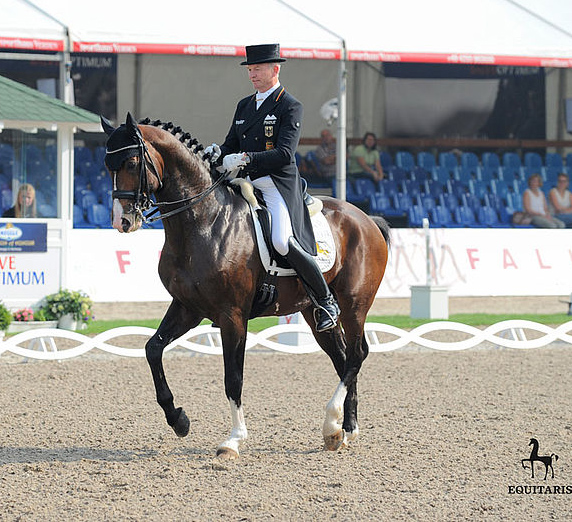
The little brother, Escorial. Photo – Tanja Becker / Equitaris
“Escolar – the big star! Aachen was only his fourth Grand Prix and his second Special, I was not so happy on the first day there were several mistakes, stupid mistakes, he started to poo when he went from walk to piaffe, then he got something in his throat before the two tempis and starts really coughing, pulls me down, forget it!”
more follows
“The breeding all started with Escolar. I loved Escolar as a four year old, and I really wanted to get him to ride, and that meant making the semen here, because from January to August, he was every day on the phantom. But when he was breeding this much, it was not really training, it was working a little bit but not like serious training. You can’t get them up to Grand Prix with this sort of work. And so I could only work in the winter time – it’s amazing, he is only ten and he is Grand Prix, even though he has been so successful as a breeding stallion. He was so successful at the Bundeschampionate, and then the first foals were really nice. When he was six, the first three year olds were already spectacular. Then in the Nürnberger in Frankfurt two years ago, he got only second in the final but okay I thought he should win, and everyone else thought that…”
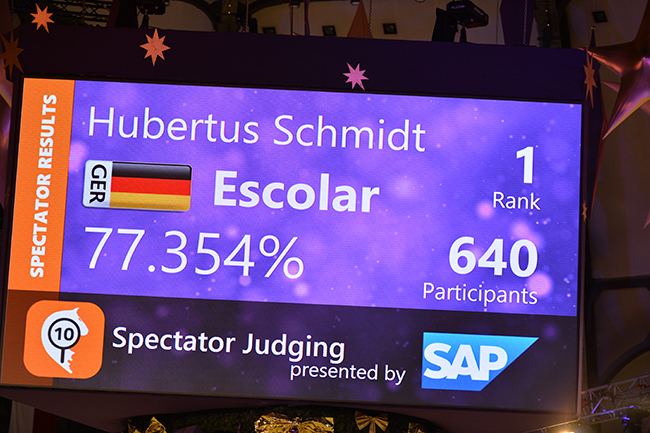
Hubertus and Escolar were clear favourites of the crowd – and were vocal when the score was announced.
Even Isabell (Werth) who rode the winning horse, thought that…
“Exactly.”
Is he the scopiest horse you’ve ever ridden?
“He is the horse with the most quality gaits. Imperio was nice, but when you see Escolar in the walk and the trot and the canter, he is the completest horse, amazing. Wansuela Suerte was completely different, today she would still score 74 but with 74 in a CDIO today, you are no-where. It has changed a lot, the quality of the horses is so amazing. The horses are so much more elastic and easier to train. Everything comes easier to them, the collection and the big forward trot – breeding has done a lot in just fifteen years.”
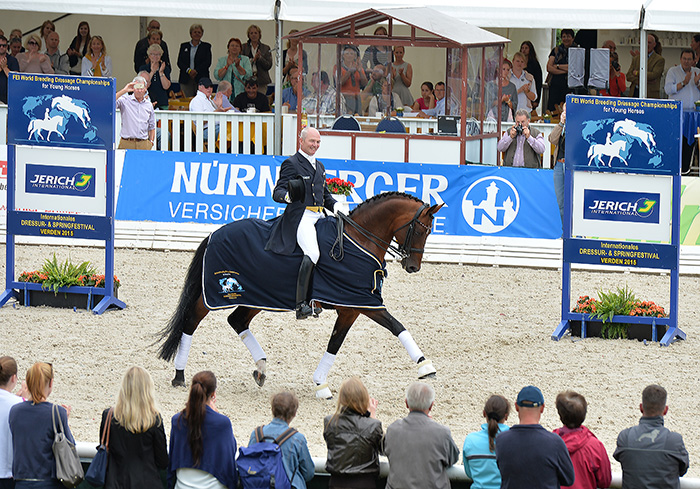
Imperio, another of Hubertus’ Grand Prix Stars
And it is not just the quality of the horses that keeps Germany out in front of the world, it is the care they take to develop their younger horses without neglecting their younger riders…
“We have this Louisdor-Prize now for the young Grand Prix horses, eight years to ten, and that is really perfect because you don’t have to compete immediately with all the top horses. All the eight and nine year olds can compete together, and that is also a lot more interesting for the owner because they can see their horse compete in the Louisdor. They qualify with the Intermediaire II and then they do the short Grand Prix, with fifteen one tempis, fifteen steps of piaffe and passage, so it’s close to a normal Grand Prix, a little bit easier because you don’t have zig zag in canter. You don’t have to do two pirouettes on one centre line.”
It has made Frankfurt in December a very special show where you have two classes for young horses, the Burg-Pokal and the Louisdor…
“Exactly, it’s really special, and now I think we are complete in Germany. We have what might be even more important, the Piaff-Förderpreise prize for the under 25-year-old riders – that was the next step, that they don’t have to go from Young Rider – at St Georg – and then immediately after that compete against the top Grand Prix riders. They have their own series, they do the short Grand Prix and Inter 2, which is perfect. In the past we had a lot of super Young Riders, winning a lot of European Championships, but then the step from St Georg to Grand Prix is really really big, it’s much bigger than from M class to S class, a lot of riders lost the enjoyment, or the parents lost patience – they have been so successful for a few years, then they fall into a hole and there is no success for a long time, but now they have a way. These three things are so important to make German dressage successful again.”
Looking at dressage today, do you think we are in a good place?
“Absolutely. Look at Aachen – amazing! – and there were no bad pictures and no bad pictures from the warm-up. We had this bad time where people worked in the wrong direction and the pity was that some people were successful with it, so more people worked in the wrong way. The good thing is that it has changed, it started with Valegro, with Damon Hill, now we have so many top top horses which are trained in the very correct and classical way.”
“Okay everywhere you can see sometimes bad pictures, sometimes you have people who are not good enough, but I know when I go to the local competitions, M and S classes, St Georg, on this level the riding is quite good and gets better and better. In Germany, England, everywhere, the riding is better, even the Dutch they start to change a little, I have the feeling that they feel they have gone the wrong way. Denmark, Sweden, there are a lot of very good Swedish riders, it has really changed, every year the horses get better and we have more and more top top riders. Twenty years ago, we had a handful, now we have twenty, thirty riders at the absolute top level.”
And for all of those twenty years, Hubertus Schmidt has reminded the world every time he enters the competition arena, that classical, quiet, gymnastic training really is the only sort that works…
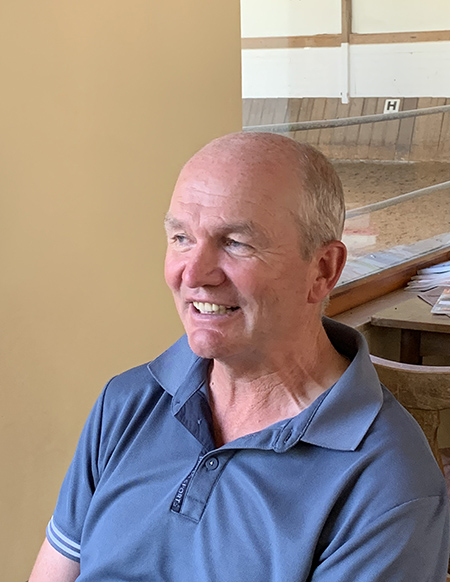
Bonifatius, a State Stud Celle stallion, available in Australia, along with many other top European stallions, from www.ihb.com.au
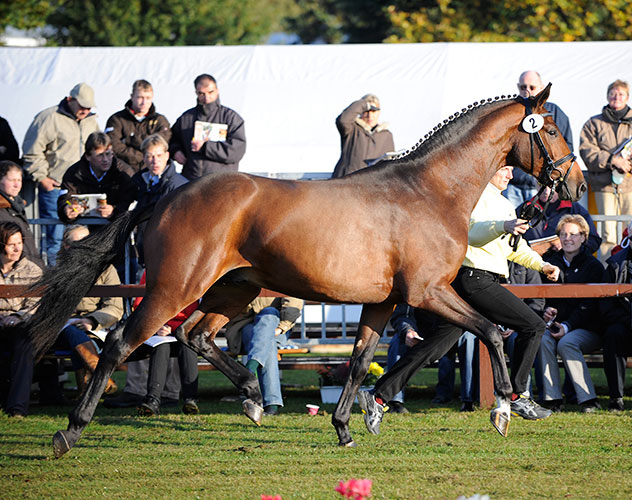
Want to breed to Bonifatius in Australia? You can, go to: www.ihb.com.au

